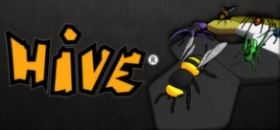
Hive Preview
Hive is a bugtastically unique puzzle-solver based on the board game of the same name. It’s a bit difficult to summarise, but it’s like a cross between chess, dominos and mahjong, with a bunch of creepy crawlies thrown in for good measure.
What makes this little bundle of buggy goodness so special is the board, or rather, lack of, that the game is played on. Instead of there being a set grid on which player pieces are placed, like the aforementioned chess and its respective board, the markers themselves actually form the board as they are put in to play.
At first, this all seems a little confusing and complicated, but it’s actually rather simple. Each player starts with eleven hexagonally-shaped pieces; three soldier ants, two beetles, three grasshoppers, two particularly sinister looking spiders, and the queen bee. The object of the game is to surround your opponent’s queen bee completely, with another piece next to each of her six sides. The encompassing markers can be either yours, or your opponents, and the first one to surround the other wins the game. Still with me? Good.

Players start by putting down their pieces, and the queen bee needs to be in play by turn four. Other than the first move, you can only place your bugs next to markers of your colour, whether that be black or white. As you put them into play, they will form the ‘board’ of sorts, and then that’s where the game really begins.
Once the bugs are in the hive, you can move them around, and start to try and accomplish your goal of surrounding the other team’s queen bee. The great part here is that, again like chess, the different types of bugs have individual methods of movement:
Soldier ants are probably the most useful pieces in the hive, as they can move anywhere around the outside edge of the hive which is handy if you need to move somewhere far away pretty fast.
Spiders can move exactly three spaces in a direct path to reach their goal, the proviso here being that they can only move around pieces they are in direct contact with, so they can’t jump across to a piece they previously weren’t touching. They also cannot backtrack on themselves, putting a limit on where they can end up each turn.
Grasshoppers, like their namesake, move by ‘jumping’ across other pieces to reach an unfilled spot. They can, however, only jump over a row of connected pieces, so you can only fill the closest gap in any given direction, and wait your next turn to get to one a bit further away.
Beetles are rather special because they can creepy crawl their way over other pieces. They’re limited to moving one space per turn, but if they land on top of another bug then it is stuck, and cannot move until the beetle goes. The only way to stop a beetle is to put another beetle on top of it; they can stack, so you could end up with all four on top of each other.
The queen bee, like the beetle can only move one space at a time, but doesn’t have the luxury of moving on top of the hive and can only move into an empty space, making her the most restricted of the bugs, whilst still being the most important. Moving her strategically will keep her out of trouble and stop the other team from surrounding her and winning the game.

Using all these pieces and their special moves is the most fun part of the game, and lovers of logic will happily spend hours battling against the computer, trying to beat all five of the difficulty levels. Keep in mind that there are a few rules that limit your moves, (be sure to read the instructions before you start) and you should be good to go.
For a ‘board game’ converted to computer format, Hive translates across really quite well and will make a great time sinker for anyone looking for a challenge to overcome with some serious strategic thinking.









COMMENTS